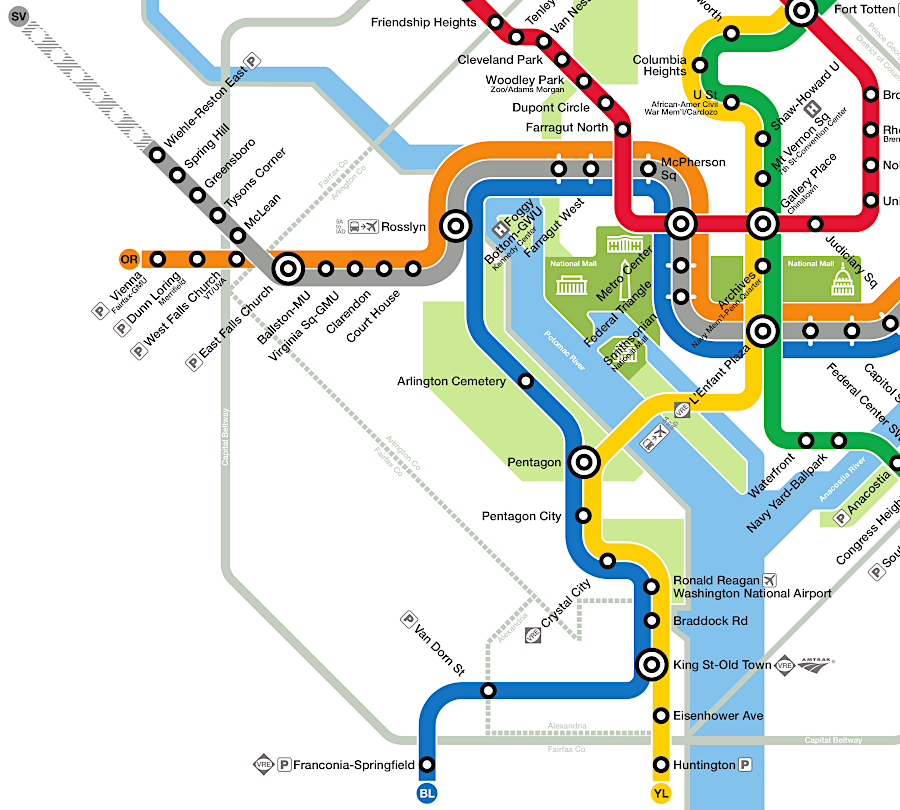
in 2019, the Silver Line was open only to Wiehle-Reston East
Source: Washington Metropolitan Area Transit Authority, System Map (2019)

in 2019, the Silver Line was open only to Wiehle-Reston East
Source: Washington Metropolitan Area Transit Authority, System Map (2019)
The development of a heavy rail transit system in Northern Virginia, Maryland, and Washington DC starts with passage of the National Capital Planning Act by the US Congress in 1952. In 1960, the Congress passed the National Capital Transportation Act, with the goal of building a rapid rail system in the DC area.
Two years later, the National Capital Transportation Agency proposed an 83-mile system with 65 stations. In 1965, President Johnson obtained the funding he requested for building a 25-mile system, and in 1967 the Washington Metropolitan Area Transit Authority replaced the National Capital Transportation Agency. It approved plans for a 97-mile "Adopted Regional System" in 1968, and voters in Arlington County, Fairfax County, City of Fairfax, and City of Falls Church approved bonds to fund their local share of costs.
In 1969, the city council in the District of Columbia capitulated to pressure from key leaders in the US Congress and authorized highway construction through the city, including the Three Sisters Bridge. That ended Congressional opposition, but later court decisions blocked the bridge and led to $2.2 billion in funding for interstate highway construction being transferred to subway construction.
The first operations of the Washington Metropolitan Area Transit Authority were to run buses, after purchasing the four private bus companies operating in the District. The first Metrorail line to operate in Virginia was the Blue Line from National Airport in 1977.
The Orange Line began operations from Ballston at the end of 1979, and was extended to Vienna in 1986. Multi-level garages were built at Vienna in 1991 and 2001, and at West Falls Church in 2004. The first eight-car trains on the Orange Line start in 2006.
The Yellow Line began running to Huntington over a new Potomac River bridge in 1983.
The Blue Line was extended from King Street to Van Dorn in 1991. A new entrance at King Street, and the new direct Metro Entrance Facility eliminating entry from Metro into the Pentagon, opened in 2002. The Blue Line reached Franconia-Springfield in 1997. The garage at Franconia-Springfield was expanded to add 1,000 more spaces in 2003.
What is now the Silver Line was approved as a 24-mile extension from West Falls Church in 2002. The first five stations, with access to Tysons, opened in 2014. The Wiehle-Reston East station was at the end of the line for the first phase of the Silver Line, and the only station with a parking garage. Completion of the second phase, with the last six stations to Ashburn (including Dulles International Airport), was planned for 2020.1
By 2019, Metrrail was the third largest heavy rail transit system in the United Stars, with 118 miles of track on six rail lines (Red, Yellow, Green, Orange, Blue, Silver), 91 stations, and 1,144 railcars. One-third of commuters at peak hours were Federal employees, but the Metrobus/Metrorail transit system had fundamentally shaped the region's land use and economic development:2
Metrorail was designed as a "hub and spoke" system to move commuters from the suburbs to the job centers within the urban core. Funding appeals to the US Congress emphasized how the rail and bus transit network would increase access to Federal facilities within the District of Columbia, reducing time wasted in commuting and improving the wfficiency of Federal employees. No line was built to Georgetown within the District because it lacked major employment centers. In addition, the foundations of the Watergate complex would have required a deep tunnel below the Potomac River and an excessively-steep climb to a station at Wisconsin Avenue and M Street.3